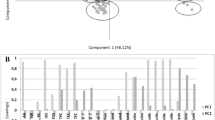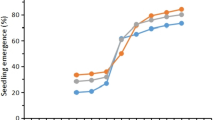Abstract
Chickpeas have large variations in their types and nutrient composition, owing to diverse environmental conditions, breeding techniques, and cultivars. Thirty-one improved varieties of chickpeas bred for various agronomic traits like high yield, resistance to diseases, and tolerance to abiotic stress were analyzed for their nutrient composition, along with two local varieties. They were found to be rich in proteins (16.09–26.22 g/100 g) and dietary fiber (10.33–26.33 g/100 g) with moderate amounts of available carbohydrates (34.20–54.72 g/100 g) and to have a significant quantity of minerals like calcium (127.50–183.86 mg/100 g), iron (4.55–8.33 mg/100 g), and phosphorous (285.92–528.31 mg/100 g). They were found to be similar (fat, carbohydrates, dietary fiber) or statistically higher (protein, ash) than the local varieties for all the nutrient parameters that were analyzed. A significant difference was also found between the desi and kabuli varieties, where the desi variety was found to have significantly lower fat and available carbohydrates but high dietary fiber content. This study signifies that the varietal differences in nutritional composition are significant in chickpeas. Varieties like Sasho, ICCV 96030, and Teketay showed desirable nutritional qualities associated with moisture, protein, dietary fiber, and minerals like zinc, phosphorous, iron, copper, and calcium. This data will be beneficial for manufacturers in the product development and value addition industries for the selection of varieties ideal for their needs since the nutrient component also confers several functional and physiochemical properties to the chickpea seed besides providing a nutritionally diverse diet.

Similar content being viewed by others
Data Availability
No datasets were generated or analysed during the current study.
References
Kamchan A, Puwastien P, Sirichakwal PP, Kongkachuichai R (2004) In vitro calcium bioavailability of vegetables, legumes and seeds. J Food Compos Anal 17(3–4):311–320. https://doi.org/10.1016/j.jfca.2004.03.002
FAO (2021) Food and Agriculture Organization of the United Nations. Data/Production/Crops and livestock products/India, World + (Total), World > (List)/Production quantity, Yield/Chick peas, Pulses, Total + (Total), Pulses, Total > (List)/2021 (pick list). https://www.fao.org/faostat/en/#home. Accessed 6 Feb 2023
PIB (2022) Second advance estimates of production of major crops for 2021–22 released. Government of India. https://pib.gov.in/PressReleasePage.aspx?PRID=1798835. Accessed 25 July 2022
FAO (2021) Food and Agriculture Organization of the United Nations. Data/Trade/Crops and livestock products/India/Import Quantity, Export Quantity/Chick peas, Pulses + (Total)/2021 (pick list). https://www.fao.org/faostat/en/#home. Accessed 6 Feb 2023
Mathew SE, Shakappa D (2022) A review of the nutritional and antinutritional constituents of chickpea (Cicer arietinum) and its health benefits. Crop Pasture Sci 73(4):401–414. https://doi.org/10.1071/CP21030
Frimpong A, Sinha A, Tar'an B, Warkentin TD, Gossen BD, Chibbar RN (2009) Genotype and growing environment influence chickpea (Cicer arietinum L.) seed composition. J Sci Food Agric 89(12):2052–2063. https://doi.org/10.1002/jsfa.3690
Jukanti AK, Gaur PM, Gowda CL, Chibbar RN (2012) Nutritional quality and health benefits of chickpea (Cicer arietinum L.): a review. Br J Nutr 108(S1):S11–S26. https://doi.org/10.1017/S0007114512000797
Medina-Lozano I, Díaz A (2021) Nutritional value and phytochemical content of crop landraces and traditional varieties. IntechOpen. https://doi.org/10.5772/intechopen.95514
FAO (2003) Food and Agriculture Organization of the United Nations. Food energy - methods of analysis and conversion factors. Report of a Technical Workshop, Rome
Rodríguez-Ramírez S, Mundo-Rosas V, Jiménez-Aguilar A, Shamah-Levy T (2009) Methodology for the analysis of dietary data from the Mexican National Health and Nutrition Survey 2006. Salud Pública Méx 51(4):S523–S529
Buckan DS (2015) Estimation of glycemic carbohydrates from commonly consumed foods using modified anthrone method. Indian J Appl Res 5(3):45–47
AOAC (2005) Official methods of analysis, 18th edn. Association of Official Analytical Chemists, Washington, D.C.
AOAC (2016) Official methods 931.01, phosphorus in plants. In: Latimer GW (ed) AOAC official methods of analysis, 20th edn. AOAC International, Rockville, MD, pp 24
MR Islam, Rahman MA, Rashid MM, Shahin-Uz-Zaman M (2013) Effect of moisture level and storage container on the quality of chickpea seed (Cicer arietinum). Bull Inst Trop Agr Kyushu Univ 36:61–69. https://doi.org/10.11189/bita.36.061
Işik E, Işik H (2008) The effect of moisture of organic chickpea (Cicer arietinum L.) grain on the physical and mechanical properties. Int J Agric Res 3(1):40–51. https://doi.org/10.3923/ijar.2008.40.51
Grasso N, Lynch NL, Arendt EK, O’Mahony JA (2022) Chickpea protein ingredients: a review of composition, functionality, and applications. Compr Rev Food Sci Food Saf 21(1):435–452. https://doi.org/10.1111/1541-4337.12878
Madurapperumage A, Tang L, Thavarajah P, Bridges W, Shipe E, Vandemark G, Thavarajah D (2021) Chickpea (Cicer arietinum L.) as a source of essential fatty acids–a biofortification approach. Front Plant Sci 12:734980. https://doi.org/10.3389/fpls.2021.734980
Nam T, Kim A, Oh Y (2023) Effectiveness of chickpeas on blood sugar: a systematic review and meta-analysis of randomized controlled trials. Nutrients 15(21):4556. https://doi.org/10.3390/nu15214556
Zhao M, Cui W, Hu X, Ma Z (2022) Anti-hyperlipidemic and ameliorative effects of chickpea starch and resistant starch in mice with high fat diet induced obesity are associated with their multi-scale structural characteristics. Food Funct 13(9):5135–5152. https://doi.org/10.1039/D1FO04354D
Begum N, Khan QU, Liu LG, Li W, Liu D, Haq IU (2023) Nutritional composition, health benefits and bio-active compounds of chickpea (Cicer arietinum L.). Front Nutr 10:1218. https://doi.org/10.3389/fnut.2023.1218468
Longvah T, Ananthan I, Bhaskarachary K, Venkaiah K (2017) Indian food composition tables. National Institute of Nutrition, Indian Council of Medical Research, Hyderabad
Desalegn BB (2015) Effect of soaking and germination on proximate composition, mineral bioavailability and functional properties of chickpea flour. Food Public Health 5(4):108–113
Sánchez-Vioque R, Clemente A, Vioque J, Bautista J, Millán F (1999) Protein isolates from chickpea (Cicer arietinum L.): chemical composition, functional properties and protein characterization. Food Chem 64(2):237–243. https://doi.org/10.1016/S0308-8146(98)00133-2
McLean RM, Wang NX (2021) Potassium. In: Eskin NAM (ed) Advances in food and nutrition research, Vol 96. Academic Press, New York, pp 89–121. https://doi.org/10.1016/bs.afnr.2021.02.013
Wallace TC, Murray R, Zelman KM (2016) The nutritional value and health benefits of chickpeas and hummus. Nutrients 8(12):766. https://doi.org/10.3390/nu8120766
Muleya M, Bailey EF, Bailey EH (2024) A comparison of the bioaccessible calcium supplies of various plant-based products relative to bovine milk. Food Res Int 175:113795. https://doi.org/10.1016/j.foodres.2023.113795
Adak MS, Kayan Nİ, Gunes A, Inal A, Alpaslan M, Cicek N, Guzelordu T (2007) Effect of harvest timing on yield and mineral nutritional value of kabuli type chickpea seeds. J plant Nutr 30(9):1397–1407. https://doi.org/10.1080/01904160701555820
Kahraman A, Ceyhan E, Harmankaya M (2015) Nutritional variation and drought tolerance in chickpeas (Cicer arietinum L.). J Elem 20(2):331–341. https://doi.org/10.5601/jelem.2014.19.2.674
El-Adawy TA (2002) Nutritional composition and antinutritional factors of chickpeas (Cicer arietinum L.) undergoing different cooking methods and germination. Plant Foods Hum Nutr 57(1):83–97. https://doi.org/10.1023/A:1013189620528
Iqbal A, Khalil IA, Ateeq N, Khan MS (2006) Nutritional quality of important food legumes. Food chem 97(2):331–335. https://doi.org/10.1016/j.foodchem.2005.05.011
Acknowledgements
The authors acknowledge the International Crops Research Institute for the Semi-Arid Tropics (ICRISAT), Telangana, India, for providing the chickpea samples.
Funding
This work was supported by the Indian Council of Medical Research (ICMR)—National Institute of Nutrition, Hyderabad, India (grant number, FCD01).
Author information
Authors and Affiliations
Contributions
Shreyas Elma Mathew: Sample preparation, analysis, drafting the original manuscript, and editing. Sumi M S: Sample preparation, analysis. Devindra Shakappa: Study design, funding acquisition, sample procurement, and supervision.
Corresponding author
Ethics declarations
Ethical Approval
Not applicable.
Competing Interests
The authors declare no competing interests.
Additional information
Publisher's Note
Springer Nature remains neutral with regard to jurisdictional claims in published maps and institutional affiliations.
Supplementary Information
Below is the link to the electronic supplementary material.
Rights and permissions
Springer Nature or its licensor (e.g. a society or other partner) holds exclusive rights to this article under a publishing agreement with the author(s) or other rightsholder(s); author self-archiving of the accepted manuscript version of this article is solely governed by the terms of such publishing agreement and applicable law.
About this article
Cite this article
Mathew, S.E., M S, S. & Shakappa, D. Comparative Nutritional Analysis of Improved and Local Chickpea (Cicer arietinum) Cultivars. Plant Foods Hum Nutr (2024). https://doi.org/10.1007/s11130-024-01181-y
Accepted:
Published:
DOI: https://doi.org/10.1007/s11130-024-01181-y




